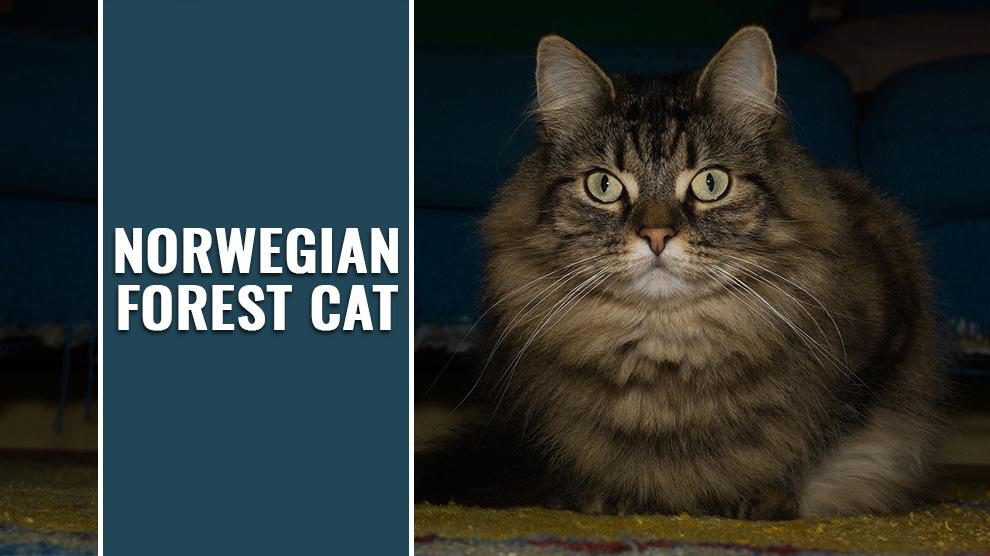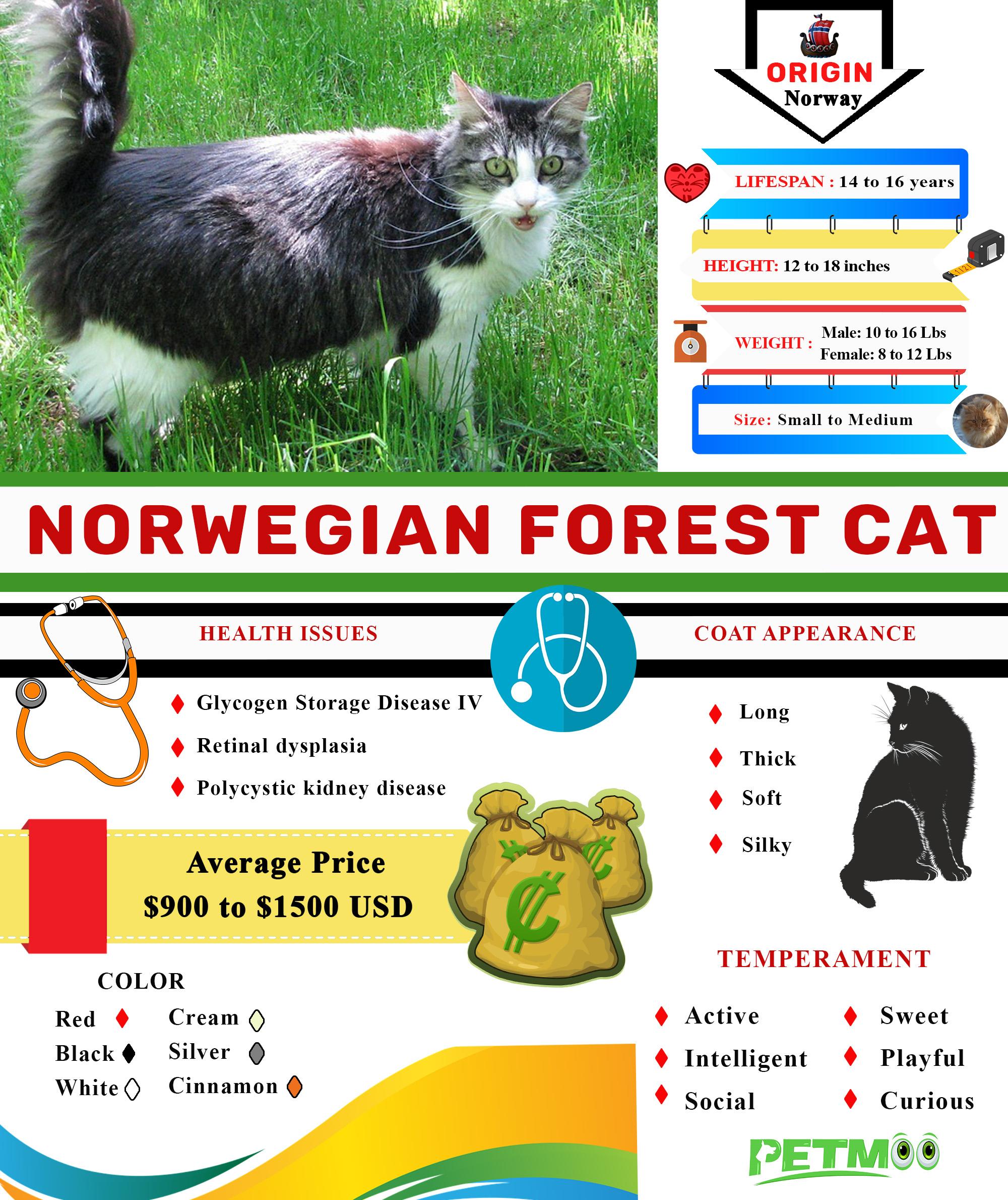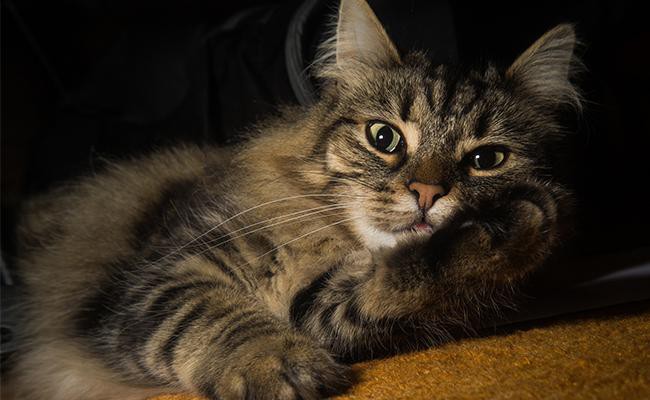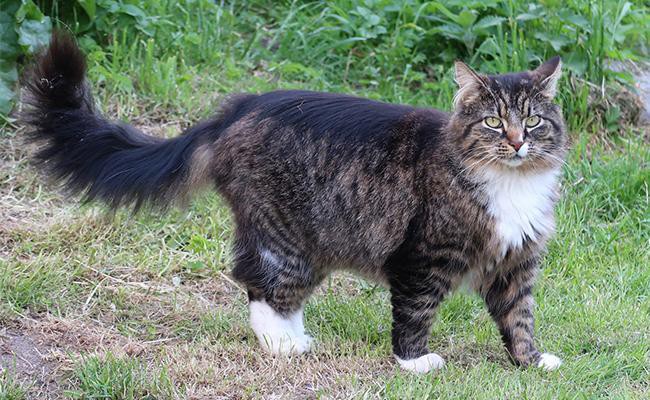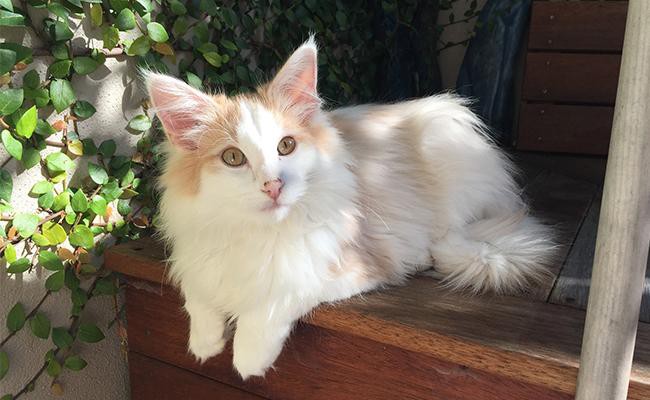Cat Pregnancy Calculator And Timeline
Looking out for a fluffy, well-muscled feline entertainer for your home? Get a Norwegian Forest Cat!
A popular breed of Norway and Sweden, the large Norwegian Forest Cat enjoys the company of pets and human companion. Gleaming with its double coat, this gentle cat breed behaves in a friendly manner with people.
It is an intelligent and social cat, too! Independent and affectionate, it needs attention but not demanding. Your family can enjoy with this easy-going, playful cat!
It will simply sit in a room with its lovely people and entertain them. This wonderful cat won’t disturb you when you are away. It will happily spend its alone hours for a reasonable amount of time.
Let’s explore more about his wonderful explorer in this article!
Norwegian Forest Cat Breed Characteristics
- Origin: Norway
- Size: Small to medium
- Purebred: Yes
- Lifespan: 14 to 16 years
- Height: 12 to 18 inches
- Weight: 10 to 16 lbs (males); 8 to 12 lbs (females)
- Coat Appearance: Long, Thick, Soft, Silky
- Coat Colors: Red, Black, White, Blue, Cream, Silver, Cinnamon
- Temperament: Sweet, Playful, Curious, Active, Intelligent, Social
- Good With Children: Yes
- Intelligence Level: High
- Good With Pets: Yes
- Hypoallergenic: No
- Grooming: Moderate
- Shedding: High
- Suitable For Apartments: Yes
- Need For Exercise: High
- Easy To Train: Yes
- Good For First Time Owners: Yes
- Health Issues: Glycogen Storage Disease IV, Retinal dysplasia, Polycystic kidney disease
- Litter Size: 4 kittens (average)
- Average Price: $600 to $1500 (approximate)
Norwegian Forest Cat History
A native of Norway, this breed has Black and White shorthair cats as ancestors. It is believed that these cats have been brought to Norway from Great Britain after 1000 AD.
The shorthair cats have been reproduced with farm and feral stock and this eventually led to the Norwegian Forest breed.
It is also believed that the longhaired cats, Siberian and the Turkish Angora from Russia and Turkey respectively, are also the possible ancestors of this breed.
In 1938, the Norwegian Forest Cat Club was formed in Oslo, Norway. But, an interruption occurred in the club’s movement to preserve this breed because of World War II.
So, this breed became endangered and nearly extinct. Later, the club developed an official breeding program and it paved the way to the renaissance of Norwegian cats.
Earlier, this cat was not registered as a breed in the Fédération Internationale Féline (FIFe). Later, with the efforts of Carl-Fredrik Nordane, a Norwegian cat fancier, this breed was registered.
In the 1970s, this cat was registered in Europe and in 1978, Sweden recognized this breed. In 1989, the United Kingdom accepted it as a breed. And, finally, by 1994, the American Cat Fanciers Association registered this breed.
Since 2003, it has been the fifth most popular cat breed in France.
Norwegian Forest Cat Description
The Norwegian Forest Cat has some resemblance of the semi-longhaired cat, the Maine Coon. It also resembles some random-bred longhaired cats.
But, there is a considerable difference. The Norwegian Forest Cat gives you the striking expression with its large, almond-shaped eyes. Its equilateral triangle-shaped head contributes to the unique appearance of this breed.
Having the heavily furnished tufted ears, it has long, plumed, bushy tail of its body length. Its body is moderately long but is powerful with a broad chest and well-muscled thighs. The paws are round, large and have tufts of fur between the toes.
Norwegian forest cat may have gold, copper or green eyes. But, white cats may have blue eyes or odd eyes (i.e. one eye is blue and another eye in a different color).
Norwegian Forest Cat Coat
This breed is notable for its thick, pretty double coat. The uniqueness of its coat is waterproof resistant nature. So, this cat can withstand the cold climates. The coat texture also matches the Scandinavian environment.
The undercoat is long, dense but having coarse hairs. And, the coat varies in length. Beginning with a short collar at the neck, you can see a full-frontal ruff. You can notice long hairs on the thighs.
Norwegian Forest Cat Coat Colors
The cot is long and flowing on the body, but it changes with seasons. And, the Norwegian Forest Cats comes in various colors from pure white to coal black. But, most of them are having brown and white coats.
This cat comes in different coat patterns, too! It will come in a pointed pattern similar to that of Siamese.
Norwegian Forest Cat Size
This breed is large. This cat stands around 12 to 18 inches. Regarding weight, male Norwegian Forest cats weigh more than the females. Males weigh around 10 to 16 pounds and the females weigh between 8 and 12 pounds!
Norwegian Forest Cat Lifespan
This cat is generally healthy and has a long life span. It lives for about 14 to 16 years with healthy and proper care. They may fall at the hurdle on the clean bill with the genetic health issues like Glycogen storage disease and heart disease.
Norwegian Forest Cat Personality
Having the name “forest cat,” this breed’s temperament is soft though.
The Norwegian forest cat is
- A loving companion – This cat is a sweet personality. It loves everyone in your family and follows its owner around wherever he goes.
- Adaptable – This breed adapts to survive the cold weather in Norway.
- Vocal – Norwegian forest cat is vocal, but it will talk to you by chirping or meowing.
- A great family pet – Its soft nature makes it a great family pet!
- Child-friendly pet – Norwegian forest cat gets along with children if you raise it from the early days. Ensure that children treat this cat with the respect it deserves.
- Lap cats – This breed can set out well as lap cats. But, it will decide when to get on or off that lap.
Norwegian Forest Cat Grooming
Norwegian Forest Cats are heavy shedders. They shed a couple of times (spring and winter) in a year. And, its coat tends to form matt or tangles. So, it requires regular brushing.
Keeping its teeth clean is also equally important to prevent periodontal disease. But, this cat doesn’t require bathing due to the water-resistant coat! But, bathing is exceptional in certain circumstances!
Overall, the wegie needs basic care apart from brushing.
- Brush its coat at least once or twice a week using a slicker brush, bristle brush or stainless steel comb. But, daily brushing will help your cat’s coat be tangle-free during the shedding seasons.
- Gently comb out tangles. Baths are rarely necessary, and their nearly waterproof coat makes it almost impossible.
- Check the ears weekly once for bad smell or redness. If the ears are dirty, wipe them using a soft damp cloth moistened with the vet-recommended gentle ear cleanser.
- Brush its teeth weekly with the vet-approved pet toothpaste to maintain good dental health and to get fresh breath. Make an appointment with the vet if needed.
- Check the eyes for any discharge and clean the eye corners weekly once with a soft, damp cloth. Ensure that you are using separate cloths for each eye to prevent the risk of infection.
- Trim its nails when needed.
- Keep the litter box clean.
It is always advisable to start grooming your cat from an early age so that it adapts to it.
Norwegian Forest Cat Food
This cat breed requires a balanced and complete food formulated for its size and activity levels. It needs a high-protein diet that has more meat content. You should remember it while trying to decide on the foods for it.
This cat may reject the food if it doesn’t comply with the cat’s preference. This breed also needs cat food specially formulated to control hairballs during shedding seasons.
Norwegian Forest Cats will mature only after it attains the age of 5. So, you have to provide food with all the nutrients for its proper growth and development before the transition to adulthood.
Norwegian Forest Cat Food Requirements
Besides the above things, please ensure the following tips while feeding this cat.
- Do not feed carbohydrate-rich foods to these cats as they will easily put on weight.
- If you’re buying cat food from pet stores, make sure that the food meets the guidelines of the American Association of Feed Control Officials (AAFCO).
- Don’t feed a large, wholemeal to it. Rather, feed it in two small, measured portions.
- If you purchase the food from pet stores, take a look at the recommended feeding amount on your cat’s food package and feed half of the amount twice.
- Two-third of food portion is enough for the cat weighing between 5 and 9 pounds.
You can also ask the veterinarian regarding the type of food (dry or wet) suitable for this breed.
Norwegian Forest Cat Facts
- A Norwegian fairy tale states that the Norse goddess Freya’s chariot was pulled by these giant cats in six numbers.
- King Olaf V designated the breed as the official cat of Norway.
- In Norway, they’re called “skogcatts”, which means “forest cats.”
- Norse legends refer to this cat as a “mountain-dwelling fairy cat having the ability to climb sheer rock faces.”
Norwegian Forest Cat Names
Looking for a neoteric name for your Norwegian forest cat? Plenty of choices are right there. But, choose the category before you search a name for it!
Generally, feline owners consider their cat’s personality and coat colors while naming them! But, you can find a name for this cat in a distinct way!
Norwegian mythological names can be the wonderful choice for your Norwegian forest cat!
Norway has a rich mythology. You can have the Norse god’s name or other inspirational names form this mythology for your feline. Names such as Freya, Odin, etc. can well suit it.
A name that depicts the heritage of northern forest can be a nitid name for it!
Norwegian Forest Cat Male Names
- Ander
- Blaze
- Cinderfur
- Destin
- Ester
- Flame
- Frode
- Magnus
- Maple
- Romeo
Norwegian Forest Cat Female Names
- Eira
- Eva
- Lena
- Lexi
- Mina
- Nava
- Poppy
- Regina
- Sadie
- Sienna
Norwegian Forest Cat Health Issues
Generally, this breed is healthy. But, you can notice a few health issues namely hypertrophic cardiomyopathy, glycogen storage disease type IV, retinal dysplasia, polycystic kidney disease and hip dysplasia in them.
Hypertrophic cardiomyopathy (HCM) – It is the most common heart disease in felines. The heart muscle will thicken (hypertrophy) and it is diagnosed using an echocardiogram.
Glycogen Storage Disease IV – A disorder that occurs when there is a deficiency in the essential enzyme required for the proper metabolism of glycogen. The altered glycogen will accumulate in the muscles and nerves.
Most kittens having this disease will die either before birth or within a few hours after birth. In rare cases, kittens won’t show signs of this disease until they are 5 months of age. You can diagnose this disease in cats through a DNA test.
Hip Dysplasia – It is more common in dogs. But, the Norwegian forest cat is prone to this hereditary defect. The hip joint will degenerate and it may lead to lameness.
Your cat having this disease may avoid jumping or move slowly. Weight loss, surgery or medication will help to get rid of the pain.
Retinal dysplasia – A health condition in which your cat’s retina may have spots, but it won’t worsen your feline’s vision.
Polycystic kidney disease – It is a genetic condition that will destroy the kidneys in a progressive manner. It can be diagnosed using ultrasound examination.
Norwegian Forest Cat Price
The Norwegian forest cat is not much expensive. It will cost around $600 to $1500 in the United States of America. You can get in the range of £500 to £650 in the United Kingdom.
But, the price of this cat will vary based on the available number of litters and demand. The purpose of breeding can also affect its cost.
The breeder will charge high for the show quality Norwegian Forest cat. But, the pet quality cat may cost lower than the show quality felines.
Norwegian Forest Cat Breeders in the United States of America
- Into Wishin Norwegian Forest Cats
Blackstone, MA 01504
Tel: (508) 415-9406
questions@iwcats.com - Endelos Glede
WA 98001
Tel: (360) 520-6627
tracy@endelosglede.com - Norsestar Norwegian Forest Cats
Frankfurt, IL 60423
Tel: (815) 469-3410
marjnelson@aol.com

